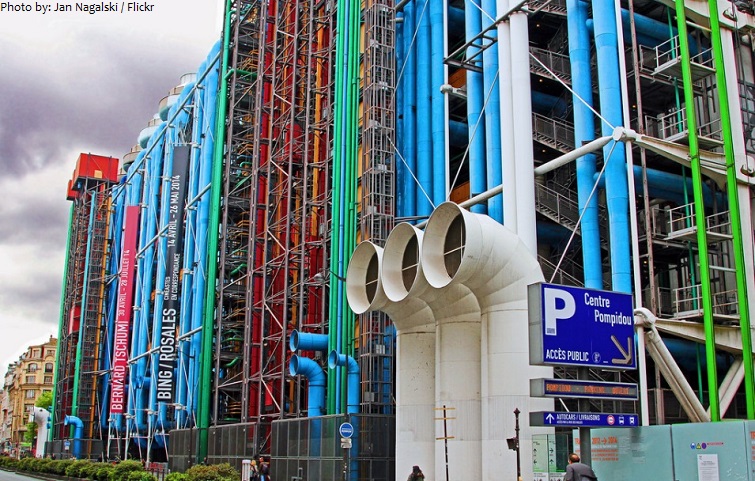I would never erase all evidence of the fire as it is a mishap that has now become part of the history of the building.
There are churches around the UK that have scorch marks on them that were left in memory of World wars.
It is said that the leaning tower of Pisa started leaning before they had even finished building it. There is a record of the rate of lean as each floor was built level the amount of slope it acquired after that remains as a record for us all to see over the years.
WHEN did the Leaning Tower of Pisa Start to Lean? - Leaning Tower Pisa
In England we are not without a leaning tower at all.
It is said that the timber was bought from a dodgy sawmill owner whom never bothered to season it.
The twist is a topic of debate too. Were the ribs supposed to be vertical or spiral?
Google Maps
There are churches around the UK that have scorch marks on them that were left in memory of World wars.
It is said that the leaning tower of Pisa started leaning before they had even finished building it. There is a record of the rate of lean as each floor was built level the amount of slope it acquired after that remains as a record for us all to see over the years.
WHEN did the Leaning Tower of Pisa Start to Lean? - Leaning Tower Pisa
In England we are not without a leaning tower at all.
It is said that the timber was bought from a dodgy sawmill owner whom never bothered to season it.
The twist is a topic of debate too. Were the ribs supposed to be vertical or spiral?
Google Maps
Attachments
Some time ago was a film about building a cathedral in England. at its opening it collapsed killing many people. A young man went to Paris to work, so he could find out the correct way of building a cathedral roof, so i guess France had the best technology. can't remember which century it was
Ancient Romans were the top builders for looooong time. Paris being closer to Rome, I guess it had architectural advantages over England, at least back in Gothic period.Some time ago was a film about building a cathedral in England. at its opening it collapsed killing many people. A young man went to Paris to work, so he could find out the correct way of building a cathedral roof, so i guess France had the best technology. can't remember which century it was
Been reading this thread and here's some tidbits in response to other posts. I'm an architect so sure, I felt that Notre Dame was an old friend from school
My understanding is that cathedral builders were itinerant and traveled from France to Italy to England and vice versa. Of course one cathedral could keep a stonemason's or freemasons family going for generations - the MASON's OMG! a conspiracy! 😉
Many ancient Roman and some Greek ruins were used as a handy "quarry" to get nice stones, and slabs of marble for new buildings in later times. Including in the renaissance Even "better" because the new churches could help destroy "pagan" buildings. But some buildings were so imposing that they were converted. The Roman Pantheon in Rome was redecorated into various christian chapels using marble from the Coliseum it is said.Better IMHO that the building was reused and not destroyed, is is so wonderful.
I have read that the Sphinx did not lose its nose to the French. Probably not to the Muslim guy either. Almost always those type of stories aren't true. However while the Parthenon was probably looted for some marble, and the statue of Athena was long gone, it was in very good shape until it was used for storing gunpowder by the Turkish army during a war in the 1800's against a foe I'm not sure of. This enemy scored a direct hit on the building and the gunpowder blew it apart. So frustrating that it survived to such a recent era only to be destroyed. The British (Lord Elgin) took the marble statues from the pediment ( the triangular part of the roof ends) years before the explosion and they now live in the British Museum. Lots of agitation for them to be returned, but if the statues had been left in the building they would have been blown up! Tough call.
My understanding is that cathedral builders were itinerant and traveled from France to Italy to England and vice versa. Of course one cathedral could keep a stonemason's or freemasons family going for generations - the MASON's OMG! a conspiracy! 😉
Many ancient Roman and some Greek ruins were used as a handy "quarry" to get nice stones, and slabs of marble for new buildings in later times. Including in the renaissance Even "better" because the new churches could help destroy "pagan" buildings. But some buildings were so imposing that they were converted. The Roman Pantheon in Rome was redecorated into various christian chapels using marble from the Coliseum it is said.Better IMHO that the building was reused and not destroyed, is is so wonderful.
I have read that the Sphinx did not lose its nose to the French. Probably not to the Muslim guy either. Almost always those type of stories aren't true. However while the Parthenon was probably looted for some marble, and the statue of Athena was long gone, it was in very good shape until it was used for storing gunpowder by the Turkish army during a war in the 1800's against a foe I'm not sure of. This enemy scored a direct hit on the building and the gunpowder blew it apart. So frustrating that it survived to such a recent era only to be destroyed. The British (Lord Elgin) took the marble statues from the pediment ( the triangular part of the roof ends) years before the explosion and they now live in the British Museum. Lots of agitation for them to be returned, but if the statues had been left in the building they would have been blown up! Tough call.
Last edited:
The damage to Notre Dame seems quite small considering the possibilities. It is true that these old cathedrals had stone walls, yet the roof was supported by wood beams because it's very hard to span that distance with stone arches, and the planking above that were covered in lead. This was a pretty great system, in that it was very weather resistant.
So the stone walls seem fine, after all stone doesn't burn- perhaps with some chips of stone "spalling" off high up due to the heat. The "Rose" stained glass windows are Ok it seems.Heat certainly could have damaged them but again- the fire was up on the roof.. and the stone walls generally fine. I wouldn't object to steel trusses to repair the roof as they aren't visible from below. Unfortunately steel is easily damaged by fire as it loses most of it's strength a remarkably low temperatures (see N.Y . twin towers-
OMG another conspiracy!) Actually not: A steel structure wouldn't "Melt " at the temperature of jet fuel burning, or a roof fire, but it loses 90% of its strength, so down goes the building. To prevent this steel needs to be encased in ugly fireproofing which is sad as it can be quite nice looking without it. the impact of a plane would dislodge that fireproofing which would again- lead to the tall buildings falling down. It's the same reason a blacksmith can easily pound a barely red hot horseshoe into shape. In Notre Dame if the wood roof framing is replaced by steel there is almost nothing flammable so maybe the insulation isn't required.
The spire, as mentioned, was designed and build in the Gothic style by a famous French architect in the 1800's who is ironically considered one of the proto-modernists. The copper gargoyles that had been moved off site foir repair, were also much newer than the original structure. Buildings are like that - constantly evolving...
So the stone walls seem fine, after all stone doesn't burn- perhaps with some chips of stone "spalling" off high up due to the heat. The "Rose" stained glass windows are Ok it seems.Heat certainly could have damaged them but again- the fire was up on the roof.. and the stone walls generally fine. I wouldn't object to steel trusses to repair the roof as they aren't visible from below. Unfortunately steel is easily damaged by fire as it loses most of it's strength a remarkably low temperatures (see N.Y . twin towers-
OMG another conspiracy!) Actually not: A steel structure wouldn't "Melt " at the temperature of jet fuel burning, or a roof fire, but it loses 90% of its strength, so down goes the building. To prevent this steel needs to be encased in ugly fireproofing which is sad as it can be quite nice looking without it. the impact of a plane would dislodge that fireproofing which would again- lead to the tall buildings falling down. It's the same reason a blacksmith can easily pound a barely red hot horseshoe into shape. In Notre Dame if the wood roof framing is replaced by steel there is almost nothing flammable so maybe the insulation isn't required.
The spire, as mentioned, was designed and build in the Gothic style by a famous French architect in the 1800's who is ironically considered one of the proto-modernists. The copper gargoyles that had been moved off site foir repair, were also much newer than the original structure. Buildings are like that - constantly evolving...
Last edited:
So buildings are kinda "funny" that way. If you leave them alone the just fall apart- ask any homeowner! So the "natural" thing to happen to old buildings is that they degenerate. The best thing to happen is that they are re-used for some other purpose or they are preserved by governments or organizations, but there is only so much money for this, so changing them to a new use is really the only option for most. And actually a "natural" thing.There are so many historic buildings in France that there's no way the government can repair them all. Italy is 10 times worse! We studied every other building there in school! Buildings have to change with the times or be lost forever, and its OK that they are changed in a sensitive way.
Current preservation philosophy is that changes should be obvious, so historians and others can clearly see what is old and what is new. So a steel roof structure might be the best thing for N.D. It won't be seen from below, only tourists on the "attic" tour, who may find it interesting.
Current preservation philosophy is that changes should be obvious, so historians and others can clearly see what is old and what is new. So a steel roof structure might be the best thing for N.D. It won't be seen from below, only tourists on the "attic" tour, who may find it interesting.
Last edited:
Mark I agree fully with the last part of your writing.If it has to be 'repaired' in this day and time, don't try to hide it! Do it in a way that shows off our current capabilities and our ideas of aesthetics, but in a way that sort of complements what's already there.
In that way it becomes a living testament of all the times it has lived through.
Jan
In that way it becomes a living testament of all the times it has lived through.
Jan
Amen! But it ain't easy to do brilliantly! Like Asian/European fusion food. Done well it's sublime, but usually it ends up the worst of both! If anyone can pull this of its the French government.
Last edited:
I love Pompidou Center! You are in a small neighborhood in Paris, go around a corner , and there it is! It isn't some show-off. I wouldn't argue that scaffolding was a reference to for the design! for the last 50 years at least, Scaffolding is the European "look"!
If you don't like the mix of modern and traditional in Paris, than you must hate everything! IMHO the French do the best job anywhere combining the traditional with the modern in large scale government controlled projects. Sure there are some huge montrosities, but look at other cities in the world, and they're vastly worse. I've lived in San Francisco more than any other city, a place that is considered one of the most atractive around, but the new buildings there are so bland it just sad! Somehow the French government encourages quality architecture while in the US we end up with the "least offensive" but least artistic buildings.
If you don't like the mix of modern and traditional in Paris, than you must hate everything! IMHO the French do the best job anywhere combining the traditional with the modern in large scale government controlled projects. Sure there are some huge montrosities, but look at other cities in the world, and they're vastly worse. I've lived in San Francisco more than any other city, a place that is considered one of the most atractive around, but the new buildings there are so bland it just sad! Somehow the French government encourages quality architecture while in the US we end up with the "least offensive" but least artistic buildings.
Last edited:
Unleash the trolls and conspiracy theorists.
One interesting note so far accredited to Bertrand de Feydeau is that “the roof’s beams can’t be remade because we don’t, at the moment, have trees on our territory the size that were cut in the 13th century”. Indeed, I should think those will be hard to find anywhere.
ferret, is the extent of damage - or complete loss- of that magnificent organ yet known?
Laminated /engineered structural lumber can be made to match or exceed the original specs and look the same.
Early sponsorship deal?
Attachments
Amen! But it ain't easy to do brilliantly! Like Asian/European fusion food. Done well it's sublime, but usually it ends up the worst of both! If anyone can pull this off its the French government.
I can't agree more. Most of the time halas the mix is a waste while the coocking technic is ok.
Modern and vintage is ok in a town but it's much more hazardous in a same building. Anyway that's very true a building has its life and also is living into a hystory. For me a restoration should show more the hystory than a single event. It's not always feasible and sometimes you can just restore things as a symbol. A perfect illustration imho was Ground zero, what the made is simply beautifull and brillant.
Last edited by a moderator:
Sicut cervus desiderat ad fontes aquarum
ita desiderat anima me ad te Deus
Giovanni Palestrina's take on Psalm 42:1, usually sung on Holy Thursday or Easter Vigil.
(You can find it in "The Rennaisance Singer")
It's really impressive how Jägermeister managed to change their image from
"secret idling mixture for galluses users" 30 years ago to "completely trendy", worldwide.
(at the Wacken open air last year)
Forward thinking marketing.
Attachments
Early reference to the same antique vision, I should imagine.Early sponsorship deal?
This being the food or the building? If former, I would agree but if latter, you may get some criticism.Amen! But it ain't easy to do brilliantly! Like Asian/European fusion food. Done well it's sublime, but usually it ends up the worst of both! If anyone can pull this of its the French government.
Sicut cervus desiderat ad fontes aquarum
ita desiderat anima me ad te Deus
Giovanni Palestrina's take on Psalm 42:1, usually sung on Holy Thursday or Easter Vigil.
(You can find it in "The Rennaisance Singer")
Baptism attribute in christian iconography. Cervus is also in the Middle Age the animal which is against the snake, so the Evil, and as is became the symbol of the Christ. Notice it s also a royaltie symbol... it makes sense.'And if you look with care you can see a double mandorl, first half circle being earth, second imo being the Cervus top and is the sky, throne of God... sorry didn t remember from what Bible writting.
It is to show off of mechanical and structural system. It did so at great compromise. 1) So much of the windows are blocked by mechanical ducts. 2) Structural steel truss had to be clad in fireproofing but then it covers up the look of steel so they wrap the fireproofing with cosmetic metal cladding to make it look like bare metal.I love Pompidou Center! You are in a small neighborhood in Paris, go around a corner , and there it is! It isn't some show-off.
1)

2)

What got built and what was imagined during design phase didn't match well at all. When it was finished, it became a cruel joke.

😱 Wow, wait till other nations hear this.I wouldn't argue that scaffolding was a reference to for the design! for the last 50 years at least, Scaffolding is the European "look"!


- Home
- Member Areas
- The Lounge
- Notre Dame cathedral




